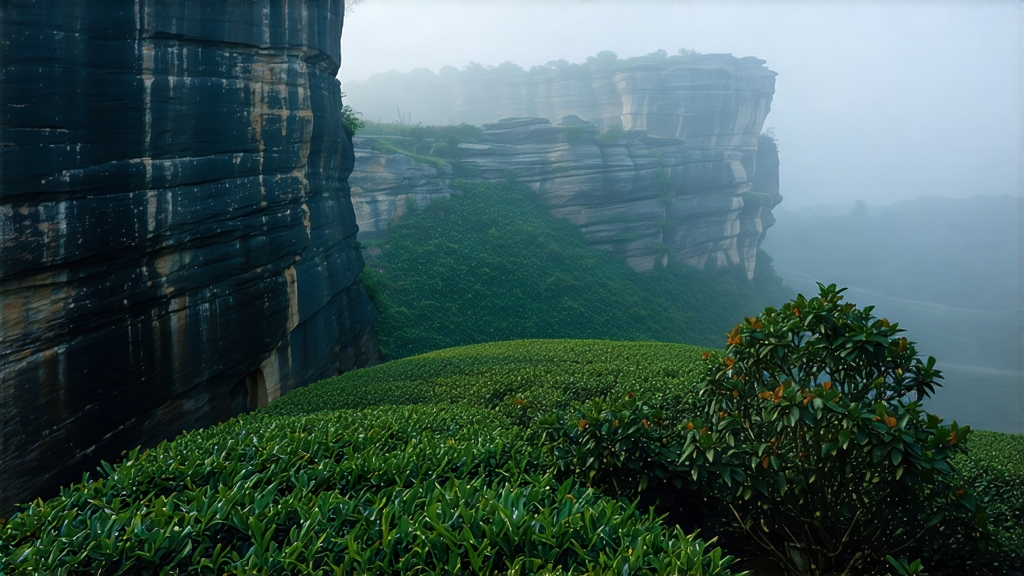
If green tea is the fresh-faced youth of Chinese tea and pu-erh the wise elder, then Da Hong Pao—Big Red Robe—occupies the charismatic middle: mature, complex, and wrapped in legend. Among the hundreds of oolongs that arc across China’s southern hills, none carries more prestige than this “King of Rock Tea” grown in the misty crevices of northern Fujian’s Wuyi Mountains. To understand Da Hong Pao is to step into a world where myth, geology, and craftsmanship converge in every amber sip.
Origin & Legend
The name first appears in Ming-dynasty county records, but oral lore pushes the story back further. The most romantic version tells of a Ming emperor’s mother, gravely ill, who was cured by tea plucked from six bushes clinging to Wuyi’s Tianxin Cliff. In gratitude the emperor sent giant red silk robes to drape over the bushes, hence “Big Red Robe.” While historians debate the medical miracle, the six mother bushes—still visible though no longer harvested—have become living monuments, their genetic fingerprint safeguarded by state-funded conservators.
Geology: Why “Rock Tea” Matters
Wuyi’s vertical canyon walls are composed of volcanic tuff and weathered granite. Rainwater filters through these minerals, picking up calcium, magnesium, and trace iron before reaching the tea roots. The result is a pronounced “yan yun” or “rock rhyme,” a tactile finish that Chinese tasters describe as the sensation of licking a wet stone. No other oolong terroir replicates this flinty minerality; it is the region’s geological signature written in flavor.
Three Tiers of Authenticity
- Mother-Tree Da Hong Pao: Cuttings from the 350-year-old bushes exist, but the original trees have not been commercially harvested since 2006. What remains in private collections sells at auction for over US$30,000 per 20 g.
- Pure-Strain Da Hong Pao: Clonal offspring (a cultivar named Qidan) grafted from the mothers. Grown in the 60 km² Wuyi core zone, these teas offer the closest genetic fidelity and command four-figure prices per 500 g.
- Blended Da Hong Pao (often labeled “Commercial DHP”): A skillful marriage of three or four Wuyi cultivars—typically Qidan, Tie Luo Han, Bai Ji Guan, and Shui Jin Gui—designed to mimic the fragrance, body, and lingering sweetness of the original. When orchestrated by a master blender, these lots deliver 80 % of the noble cup at 10 % of the price.
Crafting the Rock Oolong
Plucking: Only the middle-sized “zhong kai mian” three- or four-leaf set is picked in late April, when the leaf’s cell walls have thickened enough to withstand the intensive roasting that follows.
Withering: Leaves are spread on bamboo sieves under the morning sun for 20–30 minutes, then moved indoors for a longer, gentle wither that reduces moisture to 65 %.
Shaking: The critical “green-making” phase lasts 6–8 hours. Handfuls of leaves are tossed in rattan trays every hour, bruising the edges so that oxidative enzymes meet air. The aroma migrates from cut grass to peach skin to orchid.
Fixation: A 250 °C wok roast for 3 minutes halts oxidation at roughly 40 %—the midpoint that defines oolong.
Rolling: The hot leaves are wrapped in cloth and rolled into tight ropes that will later unfurl like miniature dragons.
Roasting & Re-roasting: Charcoal embers—usually from locally harvested Chinese red pine—are banked in ash to maintain 80–90 °C. The tea sits in rattan sieves 60 cm above the coals for 2–3 hours, rests for a month, then is roasted again. Top-grade DHP may endure three cycles across half a year, each round lowering both moisture and vegetal bitterness while caramelizing sugars into honey, cocoa, and toasted nut notes.
Tasting Lexicon
Western cuppers often reach for Burgundian metaphors. Expect:
- Dry leaf: dark chocolate shavings, burnt sugar, a whiff of pipe tobacco.
- Liquor: mahogany with a golden rim; body silky enough to coat a spoon.
- Aroma: upfront orchid, then cedar bark, then a cooling camphor lift.
- Finish: the